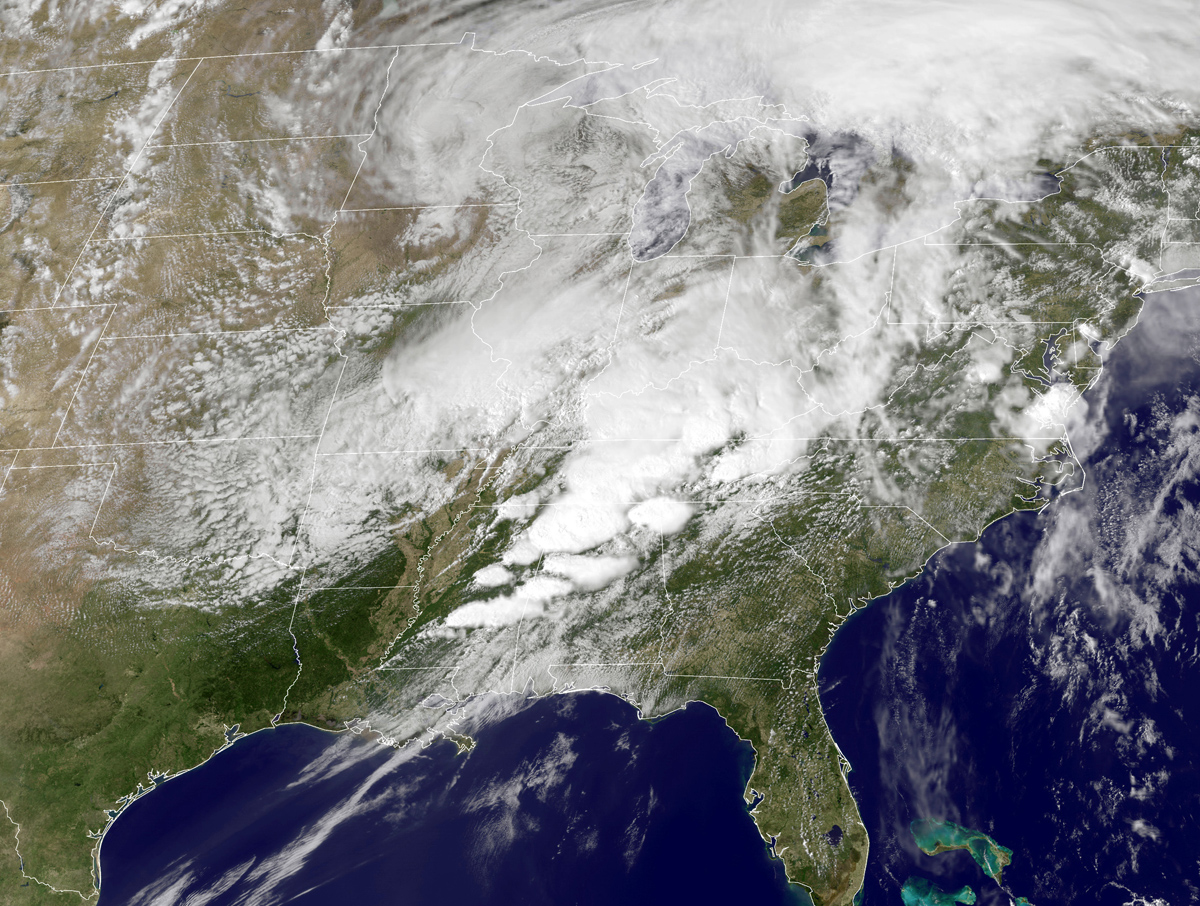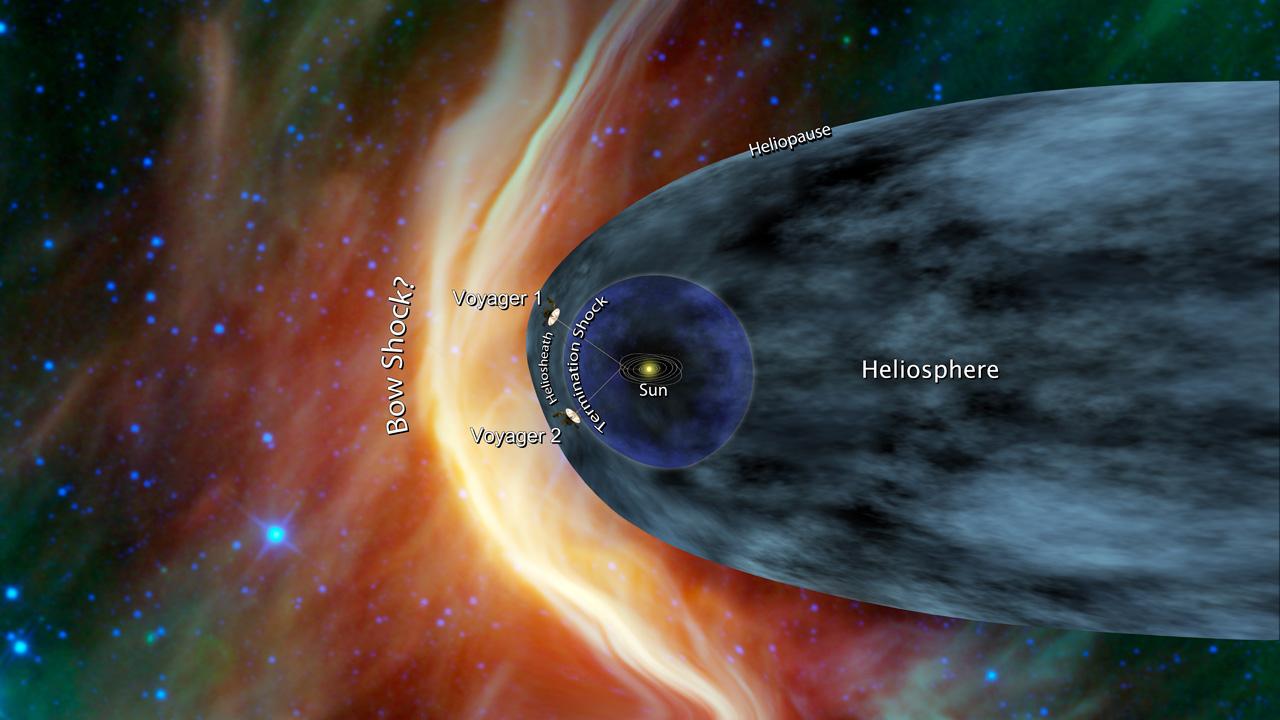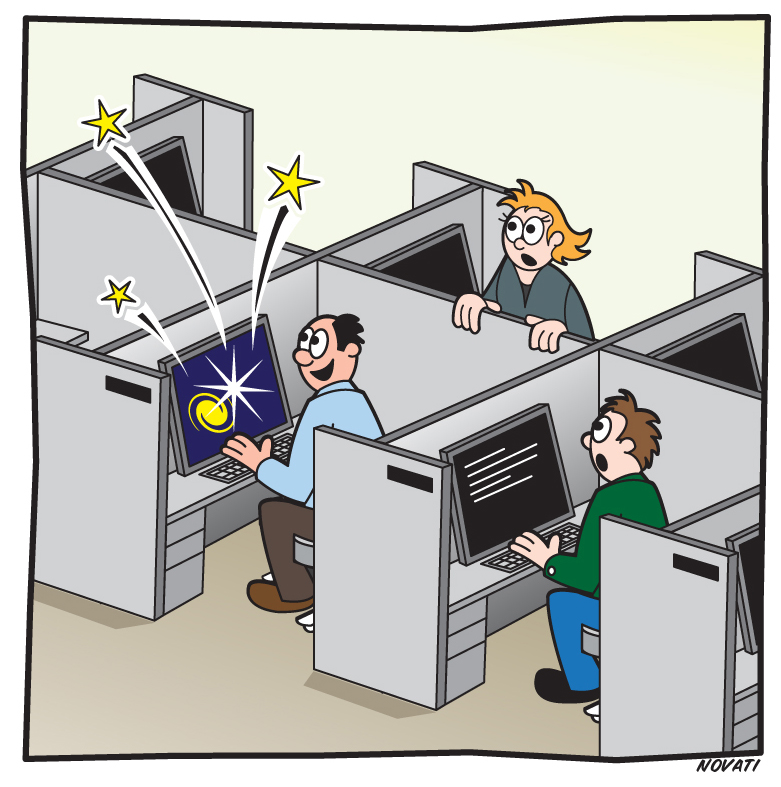Next Launch
Total Students
2,609
Total Launches
683
Eggs Survived
418 61.2%
Rockets Survived
536 78.5%
July 1, 2011
New GOES-R to give more Tornado Warning Time
by Dauna Coulter and Dr. Tony Phillips
So far this spring, more than 1,400 tornadoes have struck the U.S. Some of them have cut jaw-dropping trails of destruction across the countryside and, tragically, across inhabited communities, too. Hundreds of lives have been lost in the onslaught.
Throughout the season, the National Weather Service has routinely issued tornado alerts. In the case of the Alabama tornadoes of April 27th, forecasters warned of severe weather five full days before the twisters struck. Because they couldn’t say precisely where the twisters would strike, however, many of their warnings went unheeded.
“If people get a hurricane warning, they often evacuate the area,” notes NOAA's Steve Goodman. “But we react differently to tornado warnings.”
Perhaps it’s because tornadoes are smaller than hurricanes, and the odds of a direct hit seem so remote. Recent pictures from Tuscaloosa, Alabama, and Joplin, Missouri, however, show the perils of playing those odds. Goodman believes that more precise warnings could save lives.
To fine-tune tornado warnings, NOAA will soon launch the first in a series of next-generation weather satellites – GOES-R (Geostationary Operational Environmental Satellites-R series). The spacecraft is brimming with advanced sensors for measuring key ingredients of severe weather including winds, cloud growth, and lightning.
“GOES-R will be the first geostationary spacecraft to carry a lightning sensor,” says Goodman, the GOES-R Program Senior Scientist. “Studies show that sudden changes in the total lightning activity correlate with storm intensity—and with tornadoes.”
The lightning mapper will detect and map not only cloud-to-ground lightning, but also bolts within and between clouds. The kind of cloud-to-ground lightning we see from our front yards accounts for only 15-20 percent of total lightning. To get a clear idea of a storm's intensity, meteorologists need to know about all the lightning—a view GOES-R can provide.
All by itself, the lightning mapper will provide 7 minutes more lead time in tornado warnings, according to Goodman. GOES-R’s state-of-the-art instruments will also improve long-range forecasts.
“The satellite's Advanced Baseline Imager (ABI), for instance, will provide a much clearer picture of clouds,” says NOAA research meteorologist Tim Schmit. Compared to lesser instruments already in orbit, ABI can better detect super-cold “overshooting tops,” evidence of enormous energy and upward velocity that correlate with subsequent severe weather.
“Accurate advanced notice of high-risk tornadic conditions can cue officials to close schools and businesses even before tornadoes are actually detected,” says Schmit.
Forecasters doubt tornadoes can ever be predicted with 100% accuracy. The twisters are just too capricious. GOES-R, however, is a step in the right direction.
Find out more about GOES-R’s unprecedented capabilities at http://www.goes-r.gov. Young people can learn more about tornadoes and all kinds of other weather at http://scijinks.gov.
This article was provided by the Jet Propulsion Laboratory, California Institute of Technology, under a contract with the National Aeronautics and Space Administration.
 This GOES image shows the storms that spurred the intense April 27 tornado outbreak in the southern U.S. Animation showing the development of weather can be seen at
http://earthobservatory.nasa.gov/NaturalHazards/view.php?id=50347.
This GOES image shows the storms that spurred the intense April 27 tornado outbreak in the southern U.S. Animation showing the development of weather can be seen at
http://earthobservatory.nasa.gov/NaturalHazards/view.php?id=50347.
Aug. 1, 2011
Solar System Size Surprise
by Dr. Tony Phillips
News flash: You may be closer to interstellar space than you previously thought.
A team of researchers led by Tom Krimigis of the Johns Hopkins University Applied Physics Laboratory announced the finding in the June 2011 issue of Nature. The complicated title of their article, "Zero outward flow velocity for plasma in a heliosheath transition layer," belies a simple conclusion: The solar system appears to be a billion or more kilometers smaller than earlier estimates.
The recalculation is prompted by data from NASA's Voyager 1 probe, now 18 billion kilometers from Earth. Voyagers 1 and 2 were designed and built and are managed by NASA's Jet Propulsion Laboratory. Aging but active, the spacecraft have been traveling toward the stars since 1977 on a heroic mission to leave the solar system and find out what lies beyond.
To accomplish their task, the Voyagers must penetrate the outer walls of the heliosphere, a great bubble of plasma and magnetism blown in space by the solar wind. The heliosphere is so big, it contains all the planets, comets, and asteroids that orbit the sun. Indeed many astronomers hold that the heliosphere defines the boundaries of the solar system. Inside it is "home." Outside lies the Milky Way. For 30+ years, the spacecraft have been hurtling toward the transition zone. Voyager 1 is closing in.
Much of Voyager 1's long journey has been uneventful. Last year, however, things began to change. In June 2010, Voyager 1 beamed back a startling number: zero. That's the outward velocity of the solar wind where the probe is now.
"This is the first sign that the frontier is upon us," says Krimigis.
Previously, researchers thought the crossing was still years and billions of kilometers away, but a new analysis gave them second thoughts. Krimigis and colleagues combined Voyager data with previously unpublished measurements from the Cassini spacecraft. Cassini, on a mission to study Saturn, is nowhere near the edge of the solar system, but one of its instruments can detect atoms streaming into our solar system from the outside. Comparing data from the two locations, the team concluded that the edge of the heliosphere lies somewhere between16 to 23 billion kilometers from the sun, with a best estimate of approximately 18 billion kilometers.
Because Voyager 1 is already nearly 18 billion kilometers out, it could cross into interstellar space at any time-maybe even as you are reading this article.
"How close are we?" wonders Ed Stone, Caltech professor and principal investigator of the Voyager project since the beginning. "We don't know, but Voyager 1 speeds outward a billion miles every three years, so we may not have long to wait."
Stay tuned for the crossing.
For more about the missions of Voyager 1 and 2, see http://voyager.jpl.nasa.gov/. Another Voyager project scientist, Merav Opher, is the guest on the newest Space Place Live cartoon interview show for kids at http://spaceplace.nasa.gov/space-place-live.
This article was provided by the Jet Propulsion Laboratory, California Institute of Technology, under a contract with the National Aeronautics and Space Administration.
 This artist's concept shows NASA's two Voyager spacecraft exploring a turbulent region of space known as the heliosheath, the outer shell of the bubble of charged particles around our sun. Image credit: NASA/JPL-Caltech.
This artist's concept shows NASA's two Voyager spacecraft exploring a turbulent region of space known as the heliosheath, the outer shell of the bubble of charged particles around our sun. Image credit: NASA/JPL-Caltech.
Oct. 1, 2011
The Gray Cubicle You Want to Work In
by Dr. Tony Phillips
It's another day at the office.
You're sitting in a gray cubicle, tap-tap-taping away on your keyboard, when suddenly your neighbor lets out a whoop of delight.
Over the top of the carpeted divider you see a star exploding on the computer screen. An unauthorized video game? No, this explosion is real. A massive star just went supernova in the Whirlpool Galaxy, and the first images from Hubble are popping up on your office-mate's screen.
It's another day at the office ... at NASA.
Just down the hall, another office-mate is analyzing global temperature trends. On the floor below, a team of engineers gathers to decode signals from a spaceship that entered "safe mode" when it was hit by a solar flare. And three floors above, a financial analyst snaps her pencil-tip as she tries to figure out how to afford just one more sensor for a new robotic spacecraft.
These are just a few of the things going on every day at NASA headquarters in Washington DC and more than a dozen other NASA centers scattered around the country. The variety of NASA research and, moreover, the variety of NASA people required to carry it out often comes as a surprise. Consider the following:
NASA's Science Mission Directorate (SMD) supports research in four main areas: Earth Science, Heliophysics, Astrophysics, and Planetary Science. Read that list one more time. It includes everything in the cosmos from the ground beneath our feet to the Sun in the sky to the most distant galaxies at the edge of the Universe. Walking among the cubicles in NASA's science offices, you are likely to meet people working on climate change, extraterrestrial life, Earth-threatening asteroids, black holes or a hundred other things guaranteed to give a curious-minded person goose bumps. Truly, no other government agency has a bigger job description.
And it's not just scientists doing the work. NASA needs engineers to design its observatories and build its spacecraft, mathematicians to analyze orbits and decipher signals, and financial wizards to manage the accounts and figure out how to pay for everything NASA dreamers want to do. Even writers and artists have a place in the NASA scheme of things. Someone has to explain it all to the general public.
Clearly, some cubicles are more interesting than others. For more information about the Science Mission Directorate, visit science.nasa.gov. And for another way to reach the Space Place, go to http://science.nasa.gov/kids.
This article was provided by the Jet Propulsion Laboratory, California Institute of Technology, under a contract with the National Aeronautics and Space Administration.
 Some of the employees of NASA?s Science Mission Directorate may work in gray cubicles, but their jobs are anything but dull. They get to study Earth, the Sun, the Solar System, and the Universe!
Some of the employees of NASA?s Science Mission Directorate may work in gray cubicles, but their jobs are anything but dull. They get to study Earth, the Sun, the Solar System, and the Universe!
Nov. 1, 2011
Re-thinking an Alien World: The Strange Case of 55 Cancri e
by Brice-Olivier Demory
Forty light years from Earth, a rocky world named “55 Cancri e” circles perilously close to a stellar inferno. Completing one orbit in only 18 hours, the alien planet is 26 times closer to its parent star than Mercury is to the Sun. If Earth were in the same position, the soil beneath our feet would heat up to about 3200 F. Researchers have long thought that 55 Cancri e must be a wasteland of parched rock.
Now they’re thinking again. New observations by NASA's Spitzer Space Telescope suggest that 55 Cancri e may be wetter and weirder than anyone imagined.
Spitzer recently measured the extraordinarily small amount of light 55 Cancri e blocks when it crosses in front of its star. These transits occur every 18 hours, giving researchers repeated opportunities to gather the data they need to estimate the width, volume and density of the planet.
According to the new observations, 55 Cancri e has a mass 7.8 times and a radius just over twice that of Earth. Those properties place 55 Cancri e in the “super-Earth” class of exoplanets, a few dozen of which have been found. Only a handful of known super-Earths, however, cross the face of their stars as viewed from our vantage point in the cosmos, so 55 Cancri e is better understood than most.
When 55 Cancri e was discovered in 2004, initial estimates of its size and mass were consistent with a dense planet of solid rock. Spitzer data suggest otherwise: About a fifth of the planet’s mass must be made of light elements and compounds—including water. Given the intense heat and high pressure these materials likely experience, researchers think the compounds likely exist in a “supercritical” fluid state.
A supercritical fluid is a high-pressure, high-temperature state of matter best described as a liquid-like gas, and a marvelous solvent. Water becomes supercritical in some steam turbines—and it tends to dissolve the tips of the turbine blades. Supercritical carbon dioxide is used to remove caffeine from coffee beans, and sometimes to dry-clean clothes. Liquid-fueled rocket propellant is also supercritical when it emerges from the tail of a spaceship.
On 55 Cancri e, this stuff may be literally oozing—or is it steaming? —out of the rocks.
With supercritical solvents rising from the planet’s surface, a star of terrifying proportions filling much of the daytime sky, and whole years rushing past in a matter of hours, 55 Cancri e teaches a valuable lesson: Just because a planet is similar in size to Earth does not mean the planet is like Earth.
It’s something to re-think about.
Get a kid thinking about extrasolar planets by pointing him or her to “Lucy’s Planet Hunt,” a story in rhyme about a girl who wanted nothing more than to look for Earth-like planets when she grew up. Go to http://spaceplace.nasa.gov/story-lucy.
The original research reported in this story has been accepted for publication in Astronomy and Astrophysics. The lead author is Brice-Olivier Demory, a post-doctoral associate in Professor Sara Seager’s group at MIT.
This article was provided by the Jet Propulsion Laboratory, California Institute of Technology, under a contract with the National Aeronautics and Space Administration.
 Artist’s rendering compares the size Earth with the rocky “super-Earth” 55 Cancri e. Its year is only about 18 hours long!
Artist’s rendering compares the size Earth with the rocky “super-Earth” 55 Cancri e. Its year is only about 18 hours long!